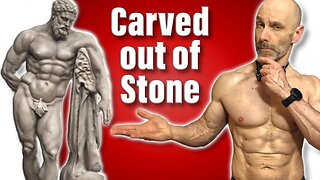Premium Only Content

Steve Reeves Workout Science Approved? (Based on the Lastest Research)
Steve Reeves Workout
Steve Reeves arguably has the most aesthetic physique of all time. He was born with a great bone structure, but the muscle he had to build, starting at 150 lbs and building himself up to 215 pounds, creating the Ultimate Natty Freak Physique.
Today we’re going to take a look at how he did it. I recently read a book that contained his training diary, and we’re going to compare his training principles to what current research is saying about maximizing muscle growth.
If you are interested in losing body fat and adding muscle, please email me at 1shark1bite@gmail.com for information on my personal training services.
Here is the link to FortisFight https://www.fortisfight.com/product-category/men/ and use my affiliate discount code FITAND50 at checkout for 15% off you next purchase on all of their apparel.
If you would like a set of Torrobands for yourself, here is my affiliate link so you can receive 50% off on your purchase https://sale.torroband.com/?affId=555B3E5D
Check your testosterone levels from home. Just click this link http://trylgc.com/laurence and receive 20% off with code: LAURENCE30 I receive commissions on referrals to LetsGetChecked. I only recommend services I know and trust.
My Affiliate link to Lebert for their Equalizer bars and more; https://lebertfitness.com/?ref=FitAnd50 and use the discount code FITAND50 you will receive 20% off your purchase
Facebook; https://www.facebook.com/Fit-and-50-5...
My Amazon page link; https://www.amazon.com/shop/fitand50
His journal contained 13 different workouts with one labelled strength recommending a rep range of 3 to 5. He mainly trained in the traditional 8 to 12 and sometimes went higher.
Many of the exercises he chose in this strength workout aren’t what we would typically think of, but In this video, we’re focusing more on his training philosophies.
If you’d like me to go over his exercise selection in the future, give this video a like and leave a comment to let me know.
When we look at the body of research on rep ranges, we find there are benefits to training in variety of ranges. What’s most important is that we train close to failure.
Steve agreed with this and would do each set with as heavy a weight as possible using a full range of motion. No part reps or cheat reps of any kind and considered failure when he could no longer do another repetition with good form. Nowadays, we call this technical failure.
The pace of his reps was slow and deliberate, with a 2 second concentric and 3 seconds eccentric. The advantage of this for Steve was the slower pace allowed him to focus on form and use a lighter weight reducing the odds of injury.
There’s a meta-analysis looking at 8 different studies on rep speed. They found muscle growth was similar whether you did a half a second repetition or went as slow as 8 seconds. Steve’s workout match’s up with this research.
He would often use short rests of 30 to 60 seconds and pyramid the weight down, starting with the heaviest weight he could handle than going lighter with each following set of an exercise.
Modern research is leaning toward longer rest times of at least 2 minutes on compound exercises and 60 to 90 seconds on isolation exercises.
I’m sure the reason Steve had to pyramid his weights was that he wasn’t fully recovered yet from his last set.
His goal was always to do more and add something every week, either another rep, set or exercise.
He did full-body training 3 times a week which was very common in his day.
His workouts were 2 to 4 hours long, having as many as 57 sets. Each body part had, on average, 3 different exercises, which he did for 3 sets.
I say on average because, in some workouts, he’d emphasize one body part over another, and overall he prioritized back and biceps more than any other body parts.
Research supports that for experienced lifters doing upwards of 20 sets per body part will bring about greater gains than doing less. But the study results have been mixed when it comes to volumes over 20. Clearly, for Steve, 27 to 30 weekly sets worked. Most of us would’t have time or energy to go past 20 sets.
With long workouts, it’s tough to keep your energy levels up.
Steve had an unusual exercise order that may have helped manage his energy better. We typically start with our heaviest lifts first while we have the most energy with exercises like squats, deadlifts, bench press, and bent-over rows.
Steve trained his delts first before moving on to chest and back. From what I’ve read, he did this to pre-exhaust them.
He worked arms next which is less fatiguing and demanding on our central nervous system, before beginning his leg work that included calves and finished off with abs.
https://journal.iusca.org/index.php/Journal/article/view/81/140
-
 4:47
4:47
Fit and 50
1 year ago $0.04 earnedThe Best Way to Choose Exercises for Muscle Growth (Greek god Physique)
5832 -
 LIVE
LIVE
VSiNLive
7 minutes agoFollow the Money with Mitch Moss & Pauly Howard | Hour 1
246 watching -
 DVR
DVR
In The Litter Box w/ Jewels & Catturd
21 hours agoFIRST 40 DAYS | In the Litter Box w/ Jewels & Catturd – Ep. 754 – 3/4/2025
15.8K12 -
 1:20:04
1:20:04
Awaken With JP
4 hours agoHow Impressive is Zelensky? - LIES Ep 81
28.2K17 -
 2:14:02
2:14:02
The Quartering
4 hours agoEpstein Files FINALLY Arrive, Zelensky CRAWLS Back & Trump Cuts Off, Oscars Sink To New Low & More
57.2K25 -
 57:11
57:11
Russell Brand
2 hours agoBREAK BREAD EP. 16 - SEAN FEUCHT
38.9K3 -
 12:20
12:20
SLS - Street League Skateboarding
4 hours agoYuto Horigome's Top Moments of 2024! All The 9's 🔥
21.6K -
 1:26:52
1:26:52
The Officer Tatum
3 hours agoLIVE: Leftists RAGE As Trump HALTS Aid to Ukraine + More | Officer Tatum Show Ep 72
32.4K9 -
 1:59:43
1:59:43
The Charlie Kirk Show
4 hours agoTariffs and Trade Wars + Peace in Ukraine? + SOTU Preview | Carney, Schweizer | 3.4.25
91.5K18 -
 43:54
43:54
Ben Shapiro
3 hours agoEp. 2150 - Trump’s STATE OF THE UNION Pledge
42.6K16